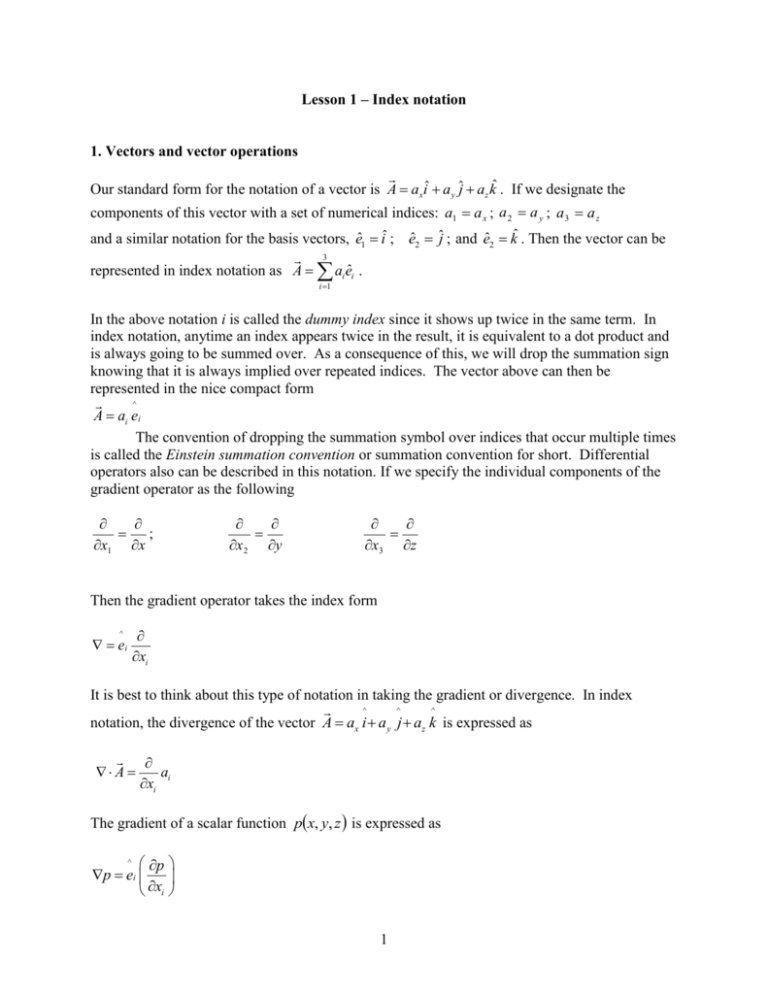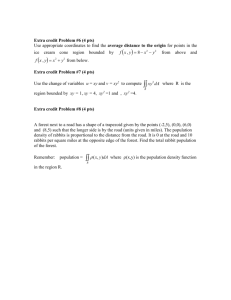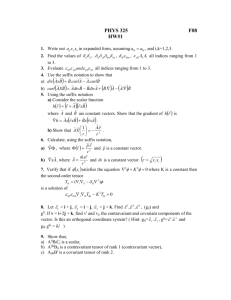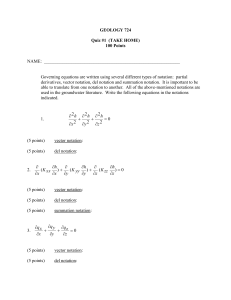SO513: Quick and dirty review of Index Notation
advertisement

Lesson 1 – Index notation 1. Vectors and vector operations Our standard form for the notation of a vector is A axiˆ a y ˆj az kˆ . If we designate the components of this vector with a set of numerical indices: a1 a x ; a 2 a y ; a3 a z and a similar notation for the basis vectors, ê iˆ ; ê ˆj ; and ê kˆ . Then the vector can be 1 2 2 3 represented in index notation as A ai eˆi . i 1 In the above notation i is called the dummy index since it shows up twice in the same term. In index notation, anytime an index appears twice in the result, it is equivalent to a dot product and is always going to be summed over. As a consequence of this, we will drop the summation sign knowing that it is always implied over repeated indices. The vector above can then be represented in the nice compact form ^ A ai ei The convention of dropping the summation symbol over indices that occur multiple times is called the Einstein summation convention or summation convention for short. Differential operators also can be described in this notation. If we specify the individual components of the gradient operator as the following ; x1 x x 2 y x3 z Then the gradient operator takes the index form ^ ei xi It is best to think about this type of notation in taking the gradient or divergence. In index ^ ^ ^ notation, the divergence of the vector A ax i a y j az k is expressed as A ai xi The gradient of a scalar function px, y, z is expressed as ^ p p ei xi 1 Kronecker Delta function: A function often used in index notation is the Kronecker delta function, ij , which is defined as follows: ij eˆi eˆ j 1 0 ij if i j if i j The Kronecker delta function is an isotropic tensor that allows us to convert or contract indices. Alternating tensor: Another important tensor in index notation is the alternating tensor (also known as the “epsilon tensor”) which has the following properties: ijk 1 if i, j, k are in cyclic order 1 if i, j, k are in anticyclic order 0 if any two indices are equal 1,2,3 or 2,3,1 or 3,1,2 3,2,1 or 2,1,3 or 1,3,2 1,1,2 or 2,1,2 or 1,3,3, etc. A very important identity is the “epsilon-delta” relation: ijk klm il jm im jl Conversion of indices For a vector u i , application of the Kronecker delta allows us to convert from the i to the j index: u i ij u j In the above equation, i is a dummy index and j is the free index. Contraction of indices For the vectors a i and b j , the direct product of these two vector is a second order tensor but application of the Kronecker delta function leads to a direct product: ai b j ij ai bi a b Example: 2 In chapter 5 we will learn about the stress tensor which is defined as ij p ij eij Currently, indices i and j are free indices in that they do not repeat in any of the terms. Now take the dot product of the above equation with the unit vector, n j , then ij n j p ij n j eij n j Now the j index is a dummy index and i is a free index. Application of the definition of the Kronecker delta function allows us to simplify the first term in the above expression: ij n j pni eij n j With a coordinate system in 3-dimensions, a vector may be presented by an ordered set of components with each having a projection on the coordinate axes 1,2,3: v1 v v2 v3 Three commonly used coordinate systems are rectangular, cylindrical, and spherical. The vector v can be represented by the sum of the magnitudes of the projections on the orthogonal axes: 3 v v1eˆ1 v2 eˆ2 v3eˆ3 vi eˆi i 1 The unit vectors eˆ1 , eˆ2 , eˆ3 are iˆ, ˆj , kˆ in Cartesian (rectangular) coordinate system, rˆ, ˆ, kˆ in cylindrical coordinate system, and rˆ, ˆ, ˆ in spherical coordinate system. Thus equivalent notation: eˆ1 , eˆ2 , eˆ3 iˆ, ˆj , kˆ aˆ1 , aˆ 2 , aˆ 3 eˆ1 eˆ1 eˆ1 eˆ1 cos 1 1 cos 0 1 eˆ2 eˆ2 eˆ2 eˆ2 cos 1 1 cos 0 1 eˆ3 eˆ3 eˆ3 eˆ3 cos 1 1 cos 0 1 3 But eˆ1 eˆ2 eˆ1 eˆ2 cos 11 cos 90 0 eˆ1 eˆ3 eˆ1 eˆ3 cos 11 cos 90 0, etc. The magnitude of the vector is given as 3 v v v12 v2 2 v32 i 1 2 i Addition and subtraction of vectors in index notation is easy: 3 a b a1 b1 eˆ1 a2 b2 eˆ2 a3 b3 eˆ3 ai bi eˆi . i 1 Multiplication by a scalar, s gives: 3 sa sa1 eˆ1 sa2 eˆ2 sa3 eˆ3 s ai eˆi i 1 The dot product of two vectors gives: 3 a b a1b1 a2b2 a3b3 aibi aibi i 1 The cross product of two vectors gives: eˆ1 eˆ2 u v u1 u2 v1 v2 eˆ3 u3 eˆ1 u2v3 u3v2 eˆ2 u3v1 u1v3 eˆ3 u1v2 u2v1 ijk uiv j eˆk kijuiv j eˆk v3 The del operator is given as eˆi eˆ1 eˆ2 eˆ3 xi x1 x2 x3 Thus the partial derivative of a scalar f f x, y, z (gradient) is represented: 4 f eˆ1 f f f f eˆ2 eˆ3 eˆi f eˆi x1 x2 x3 xi xi The Laplacian of a vector is the following: a 2u u 2u j 2 a j eˆi eˆi uj 2 uj xi 2 xi xi xi Divergence of a vector u : u u ui i xi xi Notice that i repeats in the divergence term, implying a dot product. Contrast this with the gradient of a vector field, which is a tensor with 9 elements: u ui eˆ j eˆi x j Curl of a vector u : u ijk u j xi eˆk 2. Tensors. A tensor is an ordered array of nine components T11 T12 T13 T Tij T21 T22 T23 T31 T32 T33 The transpose of a Tensor, T T , simply interchanges the elements of each element 5 T Tij T T T11 T21 T31 T ji T12 T22 T32 . T13 T23 T33 The dyadic product (not to be confused with the dot product) of two vectors results in a tensor: u1v1 u1v2 u1v3 uv ui v j u2v1 u2v2 u2v3 u3v1 u3v2 u3v3 Thus the gradient of a vector can be represented as the following. u x ui v u x j x w x u y v y w y u z v . z w z When the vector above is the velocity vector, the resulting velocity gradient is a two-dimensional tensor that determines the distortion of a fluid element as it moves. The velocity gradient can be separated into symmetric eij and antisymmetric wij components: u ui eij rij , x j where 1 u u eij i j 2 x j xi and 1 u u rij i j . 2 x j xi 6 The symmetric component, eij defines the rate of strain or deformation tensor acting on the fluid element. The diagonal components of e characterize the rate of stretching (aka longitudinal deformation, or variations of velocity in the direction of motion). For example, e11 describes the u rate of change of the east-west motion in the east-west direction, . All three components of x stretching give the trace of e and the divergence of the velocity field: ui u , xi which represents the rate of increase in volume (or dilation) of the fluid element. The offdiagonal elements of e describe the rate of shear, or transverse deformation (orthogonal to the motion). The antisymmetric component of the velocity gradient, rij , is called the rotation tensor. It has no diagonal elements and describes relative motion, not deformation. It contains only three independent components and is related to the vorticity vector: 1 r dx dx 2 Tensors are easily added, in a manner similar to vectors: A11 B11 A B A21 B21 A31 B31 A12 B12 A22 B22 A32 B32 A13 B13 3 3 A23 B23 Ai j Bij eˆi eˆ j i 1 j 1 A33 B33 The double dot product of two tensors results in a scalar: A11 B11 A:B A21B12 A31 B13 A12 B21 A22 B22 A32 B23 A13 B31 3 3 A23 B32 Ai j B ji i 1 j 1 A33 B33 And the dot product of a vector with a tensor is: eˆ1 u1B11 u2 B21 u3 B31 3 3 u B eˆ2 u1B12 u2 B22 u3 B32 eˆi u j B ji i 1 j 1 eˆ3 u1B13 u2 B23 u3 B33 7






